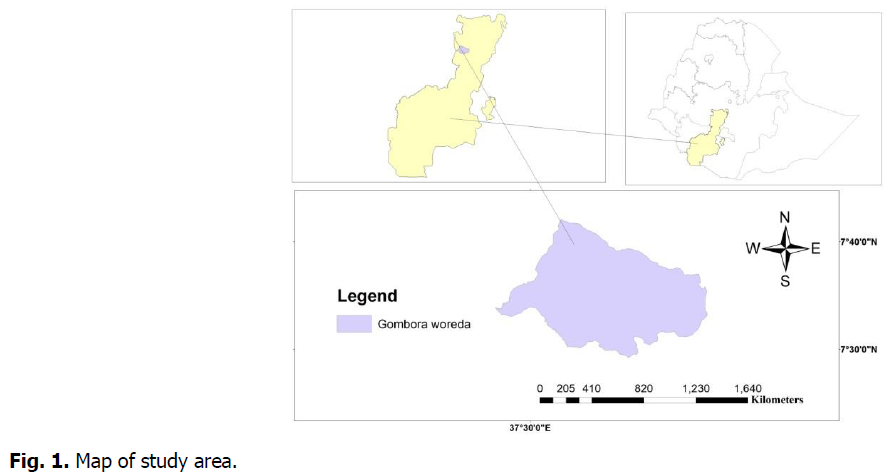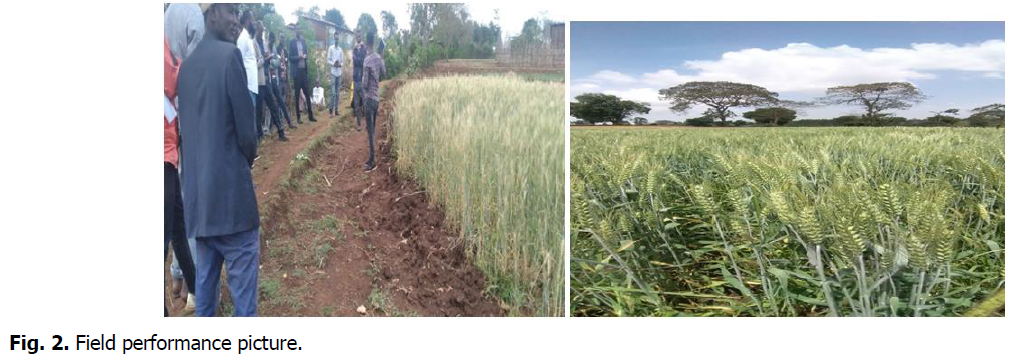Research - (2023) Volume 13, Issue 3
Participatory demonstration of irrigation scheduling on bread wheat (Triticum aestivum) production and water productivity in PASIDP-II target area, southern Ethiopia
T. Bekele*Abstract
Water is becoming scarce resource due to human induced and natural climatic variability. Improving water productivity in agricultural use is one of the important strategies to address present and future water scarcity. This on farm demonstration was done to assess irrigation scheduling effect on wheat production and water productivity on six clustered model farmers field in Gombora passidp-II target irrigation schemes, Hadiya Zone, Ethiopia in 2022 main Irrigation season. The comparative treatments were Full Irrigation (100% ETc) (10 days irrigation interval) and Farmer Practices (15 days interval) as control. Plot size was 20 m by 20 m on each farmer field. One year result shows that at Gombora scheme, an average minimum wheat yield 14.07 kuntals/ha obtained from farmers’ practices in 15 day interval. Whereas 25.23 kuntals/ha obtained from full irrigation application in 10 days irrigation interval based on CWR throughout season. Farmers during field visit also confirmed that using irrigation scheduling in 10 days interval with full irrigation application resulted better field performing and yielding of wheat. So, these indicated that it was possible to produce wheat by irrigation and demonstrate this better performing technology with full package in large scale.
Keywords
Demonstration, Irrigation scheduling and Water productivity, Wheat (Triticum aestivum).
Introduction
Water scarcity has become a global issue with a significant effect on agricultural production (Eck, M. et al., 2020). According to the recent report (World Bank, 2021) irrigation covers more than 20% of global cultivated lands and contributes to more than 40% of global total food production. Agriculture under unfavorable climatic and scarce water conditions cannot be profitable unless on-farm water management techniques are introduced (F.C. Oad, et al., 2001). The scarce water resources forces water managers to apply irrigation water efficiently in order to produce more food.
Wheat (Triticum aestivum L.) has been adopted mostly as a food crop worldwide and is the world’s most widely distributed cereal after maize, ranking eighth in the world. However, growers are concerned about its long-term production and yield in water-stressed conditions (Pequeno D., et al., 2021). Wheat farmers are currently facing a number of challenges, including water shortages and uncertain water delivery schedules (Khuhro W.A. et al, 2018).
Irrigation scheduling methods are based on two approaches, soil measurements and crop monitoring (Hoffman et al., 1990). Irrigation scheduling involves determining both the timing of irrigation and the quantity of water to apply. Efficient scheduling of irrigation water applications gives the highest return for the least amount of water (Werner, 2002). Therefore, to demonstrate the effect of irrigation scheduling on wheat production and water use efficiency and to assess farmers’ preferences on best preforming irrigation schedulling with full agronomic practices.
Objectives
• To demonstrate the effect of irrigation schedulling with full irrigation application on wheat production and water use efficiency
• To assess farmers preferences on irrigation schedulling with full agronomic practices
Materials and Methods
Description of the study areas
The demonstration was done in passidp-II targeted irrigation schemes at Gombora woreda/Gombora scheme in Hadiya zone of Southern Ethiopia. The activities were conducted in collaboration with SARI and PASIDP-II project donors. Accordingly periodical supervision and monitoring was jointly done by the SARI and PASIDP-II coordinators and the respective Zonal and districts focal persons. Moreover, close follow up done by the werabe agricultural research center irrigation researchers, members of FREG, Kebele experts and focal persons of the project in the study areas. Location of study areas were below in Fig. 1.

Fig. 1: Map of study area.
Agronomic management
Wheat agronomic practices under both irrigation schemes mentioned in Table 1 below carried out. Recommended fertilizer rate and urea top-dressing, spacing, chemicals applications were as per recommendations made in package for crops in the study areas. To control weed competition for essential nutrients, manual and recommended chemical (Palace) were used at the middle stage.
| Implementing Center |
Schemes | Woreda | Crop | Spacing of furrow | Variety | Seed rate (Kg) |
Fertilizer | |
|---|---|---|---|---|---|---|---|---|
| NPS (kg) |
Urea (kg) |
|||||||
| Werabe Agricultural Research Center | Gombora | Gombora | Wheat | 40 cm | Ogolcho | 120 | 150 | 150 |
Table 1. Implemented schemes and agronomic parameters.
Treatments
1. Full Irrigation application (100% ETc) (10 days irrigation interval)
2. Farmer Practices (15 days interval)
Replication=Six clustered farmer as replication
Plot size=20 m × 20 m
Crop water determination and irrigation scheduling
Crop water requirement refers to the amount of water that needs to be supplied, while crop evapotranspiration refers to the amount of water that is lost through evapotranspiration (Allen et al., 1998). For the determination of crop water requirement, the effect of climate on crop water requirement which is the reference crop evapotranspiration (ETo) and the effect of crop characteristics (Kc) are important (Doorenbos and pruitt, 1977). The long term and daily climate data like maximum and minimum air temperature, relative humidity, wind speed, sunshine hours and rainfall data of the study area were collected to determine reference evapotranspiration. Crop data like crop coefficient, growing season and development stage, effective root depth, critical depletion factors and total available water of the soil was be determined to calculate crop water requirement using CropWat 8.0 model.
ETc=ETo × Kc
Irrigation water management
The total available water (TAW), stored in a unit volume of soil was be determined by the expression.
TAW=[(FC-PWP) × Bd × Dz]/100
For maximum crop production, the irrigation schedule should be fixed based on readily available soil water (RAW). The RAW could be computed from the expression:
RAW=(TAW × p)
Where: RAW in mm, p is in fraction for allowable/permissible soil moisture depletion for no stress (in this case p=0.5) and TAW is total available water in mm.
The depth of irrigation supplied at any time can be obtained from the equation
NI(mm)=(ETcmm-Peffmm), this case Peffmm=0
So, Inet(mm)=(ETcmm)
The gross irrigation requirement (dg) was computed by adopting a field application efficiency of 60% (FAO, 1989). Ea=application efficiency of the furrows (60%).
dg=NI/Ea
The time required to deliver the desired depth of water into each plot calculated using the equation:
t=(l*w*dg)/6Q
Where: dg=gross depth of water applied (cm), t=application time (min), l=furrow length in (m), w=furrow spacing in (m), and Q=flow rate (discharge) (l/s).
Implemented approach
Participatory on farm demonstration approach implemented to boost adoption of irrigation scheduling practices on bread wheat production. All members of FREGs were actively involved on training of irrigation furrow preparation, sowing, water applying and weed management practices up to harvesting. Six model trial farmers selected from FREG members by considering on willingness to participate, availability of suitable farmland and access to road facility, and as much as possible female households.
Organizing field day
Prior to implementing the activities in the target area both theoretical and on-farm orientation were given to all members of FREG and Kebele experts in each irrigations scheme demonstration sites to enabling the target participant farmers to acquire awareness and practical skill on the improved irrigation management practices. Field visit conducted by inviting members of the FREGs, model farmers in the localities, key stakeholders from the corresponding kebele’s, Districts, Zones and SNNPR were participated in the field day demonstration.
Agronomic practices and management
The crops and irrigation used recommended package (fertilizer rate and Urea, spacing, chemicals for weed and disease management). To control weed competition for essential nutrients appropriate weed control techniques will be applied during plant growth period.
Collected data
•; The amount of irrigation water applied at each irrigation application, Yield and components, farmers preferences and Agronomic data
Data analysis
• The collected data were analyzed using Statistical Agricultural Software (SAS) and descriptive method.
Results and Discussion
The result shows that there was no statistical significant difference between treatment mean in plant height. But there were statistical significant difference between treatment mean both in biomass and yield. Maximum yield (25.32 kuntal/ha) was obtained from treatment having full irrigation application (in 10 days irrigation interval) whereas minimum yield (14.07 kuntal/ha) was obtained from farmer practice (in 15 days irrigation interval) (Table 2 and Fig. 2).
| Treatments | Ph(cm) | BM(kuntal/ha) | Yield(kuntal/ha) |
|---|---|---|---|
| Full irrigation (100% ETc) | 79.65 | 43.13a | 25.23a |
| Farmer practices | 72.40 | 23.81b | 14.07b |
| CV | 7.67 | 14.43 | 27.96 |
| LSD (0.05) | NS | 8.78 | 9.98 |
Table 2. Mean yield and yield component wheat data.

Fig. 2: Field performance picture.
During maturity stage, farmers and other stockholder field day was conducted to share experiences of best practice done on demonstrated site. On the field day participants such as Zone PASSIP-II focal, woreda administration, woreda PASSIP-II focal, woreda agricultural development, woreda farm manager, Irrigation experts, horticultural expert, SWC expert, kebele’s DAs, kebele’s administration and 30 farmers, totally 40 stockholders were participated. Finally farmers’ preferences were collected from sample farmers.
On both schemes, more than 90% of the farmers replied that producing wheat with irrigation was new technology for them and which very amazing technology at the beginning. But during maturity period they were visited field performance; they accepted and confirmed when wheat production by irrigation. And they have looked the difference in the field and selected and witness on best performing technology based on its field performance. Based on these evidences following conclusions were made from the demonstration.
Conclusion
An Average wheat yield obtained from 6 demonstrated farmers field was 14.07 kuntal/ha from farmers practices (15 day interval). Whereas 25.23 kuntal/ha from furrow irrigation with full water application in 10 days irrigation interval based on CWR throughout season. Therefore, these indicated that it was possible to produce wheat by irrigation and demonstrate this best yielding technology with full package in large scale in both schemes.
References
Allen, R.G., Pereira, L.S., Raes, D., Smith, M. (1998). Crop evapotranspiration-Guidelines for computing crop water requirements-FAO Irrigation and drainage paper 56. Fao, Rome, 300:D05109.
Doorenbos, J., Pruitt, W.O. (1977). Crop water requirements. FAO irrigation and drainage paper 24. Land and Water Development Division, FAO, Rome.
Eck, M.A., Murray, A.R., Ward, A.R., Konrad, C.E. (2020). Influence of growing season temperature and precipitation anomalies on crop yield in the southeastern United States. Agricultural and Forest Meteorology, 291:108053.
Oad, F.C., Soomro, A., Oad, N.L., Abro, Z.A., Issani, M.A., Gandahi, A.W. (2001). Yield and water use efficiency of sunflower crop under moisture depletions and bed shapes in saline soil. On-line Journal of Biological Sciences, 1:361-362.
Hoffman, G.J., Howell, T.A., Solomon, K.H. (1990). Management of farm irrigation system. ASAE St. Joseph, Mi.
Khuhro, W.A., Kandhro, M.N., Sadiq, N., Jakhro, M.I., Amanullah, N.S.N., Ahmed, S., Latif, A. (2018). Impact of irrigation stress on agronomic traits of promising wheat varieties in Tandojam-Pakistan. Pure and Applied Biology (PAB), 7:714-720.
Pequeno, D.N., Hernandez-Ochoa, I.M., Reynolds, M., Sonder, K., MoleroMilan, A., Robertson, R.D., Asseng, S. (2021). Climate impact and adaptation to heat and drought stress of regional and global wheat production. Environmental Research Letters, 16:054070.
FAO. (2021). World Food and Agriculture. Statistical Year book 2021. Rome.
https://www.worldbank.org/en/topic/water-in-agriculture
Werner, H. (1992). Measuring soil moisture for irrigation water management. Cooperative Extension Service, South Dakota State University, US Department of Agriculture.
Author Info
T. Bekele*Citation: Bekele, T. (2023). Participatory demonstration of irrigation scheduling on bread wheat (Triticum aestivum) production and water productivity in PASIDP-II target area, southern Ethiopia. Ukrainian Journal of Ecology. 13:33-37.
Received: 20-Mar-2023, Manuscript No. UJE-23-93688; , Pre QC No. P-93688; Editor assigned: 22-Mar-2023, Pre QC No. P-93688; Reviewed: 03-Apr-2023, QC No. Q-93688; Revised: 08-Apr-2023, Manuscript No. R-93688; Published: 15-Apr-2023, DOI: 10.15421/2023_437
Copyright: This is an open access article distributed under the terms of the Creative Commons Attribution License, which permits unrestricted use, distribution, and reproduction in any medium, provided the original work is properly cited.
